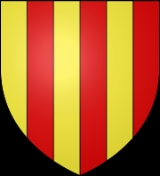
House of Amboise
Encyclopedia

Amboise
Amboise is a commune in the Indre-et-Loire department in central France. It lies on the banks of the Loire River, east of Tours. Today a small market town, it was once home of the French royal court...
, a town which it possessed as a seigneurie
Fiefdom
A fee was the central element of feudalism and consisted of heritable lands granted under one of several varieties of feudal tenure by an overlord to a vassal who held it in fealty in return for a form of feudal allegiance and service, usually given by the...
. The oldest of the house's family lines to be attested in the written sources comes from Touraine
Touraine
The Touraine is one of the traditional provinces of France. Its capital was Tours. During the political reorganization of French territory in 1790, the Touraine was divided between the departments of Indre-et-Loire, :Loir-et-Cher and Indre.-Geography:...
and dates to 1155. The text mentioning it traces the lives of the lords of Amboise and celebrates the virtues of each lord in turn
Originally the lords of Amboise were the vassal
Vassal
A vassal or feudatory is a person who has entered into a mutual obligation to a lord or monarch in the context of the feudal system in medieval Europe. The obligations often included military support and mutual protection, in exchange for certain privileges, usually including the grant of land held...
s of the first counts of Anjou but after several controversies with them the lords became independent, obtaining sizeable fiefdoms such as the Viscountcy of Thouars and Principality of Talmont. This powerful knightly family was called "the family of Mars". Its eldest branch ran until the 15th century with Louis d'Amboise, lord of Amboise, viscount of Thouars. The line of the cadet branch, with a magnificent estate at Chaumont-sur-Loire
Chaumont-sur-Loire
Chaumont-sur-Loire is a commune in the Loir-et-Cher département in central France.-See also:* Château de Chaumont* Communes of the Loir-et-Cher department...
, has continued uninterrupted to this day, via Pierre d'Amboise
Pierre d'Amboise
Pierre d'Amboise was a French nobleman of the House of Amboise. He was a son of Hugh VIII of Amboise, who was killed at the battle of Agincourt, and of Jeanne de Guénand...
, governor of Touraine and advisor to the French kings Charles VII
Charles VII of France
Charles VII , called the Victorious or the Well-Served , was King of France from 1422 to his death, though he was initially opposed by Henry VI of England, whose Regent, the Duke of Bedford, ruled much of France including the capital, Paris...
and Louis XI
Louis XI of France
Louis XI , called the Prudent , was the King of France from 1461 to 1483. He was the son of Charles VII of France and Mary of Anjou, a member of the House of Valois....
.
Members
- the surgeon Jacques d'AmboiseJacques d'Amboise (doctor)Jacques d'Amboise was a French doctor and surgeon.- Life :He was the grandson of Michel d'Amboise and the son of Jean d'Amboise, surgeon to kings Francis I of France, Henry II, Francis II, Charles IX and Henry III....
- Pierre d'AmboisePierre d'AmboisePierre d'Amboise was a French nobleman of the House of Amboise. He was a son of Hugh VIII of Amboise, who was killed at the battle of Agincourt, and of Jeanne de Guénand...
- Georges d'AmboiseGeorges d'AmboiseGeorges d'Amboise was a French Roman Catholic cardinal and minister of state. He belonged to the house of Amboise, a noble family possessed of considerable influence: of his nine brothers, four were bishops. His father, Pierre d'Amboise, seigneur de Chaumont, was chamberlain to Charles VII and...
and Jacques d'AmboiseJacques d'Amboise (bishop)Jacques d'Amboise was a French religious dignitary and patron of medieval France. He was abbot of Jumièges then of Cluny, and bishop of Clermont. He was a member of the House of Amboise, an old noble family.-Life:...
, sons of the former
Origins
Dating back to well before 1000, the first members of the family distinguished themselves under the counts of Anjou in repulsing VikingViking
The term Viking is customarily used to refer to the Norse explorers, warriors, merchants, and pirates who raided, traded, explored and settled in wide areas of Europe, Asia and the North Atlantic islands from the late 8th to the mid-11th century.These Norsemen used their famed longships to...
attacks along the River Loire. Lisois de Bazougers, issue of the Bazougers and Lavardin families and founder of the house of Amboise, was the main military leader of the powerful count of Anjou Fulk III. To reward Lisois for his services, Nerra granted him Amboise (the Roman Vicus ambaciensis, Ambacques, Castrum ambacianum, then, Ambacia, Ambaces, Amboyse, and finally Amboise) shortly before 1000 and in honour of this Lisois de Bazougers changed his name to Lisois d'Amboise.

Crusades
Lisois's grandson Hugh of Amboise was one of the first to reply to the call from Pope Urban IIPope Urban II
Pope Urban II , born Otho de Lagery , was Pope from 12 March 1088 until his death on July 29 1099...
in 1096. He set out from the abbaye de Noirmoutier with several lords of Touraine to fight in the First Crusade
First Crusade
The First Crusade was a military expedition by Western Christianity to regain the Holy Lands taken in the Muslim conquest of the Levant, ultimately resulting in the recapture of Jerusalem...
of Godefroy de Bouillon. In the following 3 years, Hugh II of Amboise fought in all the crusader battles in Palestine (the 1097 Siege of Nicaea
Siege of Nicaea
The Siege of Nicaea took place from May 14 to June 19, 1097, during the First Crusade.-Background:Nicaea , located on the eastern shore of Lake İznik, had been captured from the Byzantine Empire by the Seljuk Turks in 1081, and formed the capital of the Sultanate of Rüm...
, the June 1098 defence of Antioch
Siege of Antioch
The Siege of Antioch took place during the First Crusade in 1097 and 1098. The first siege, by the crusaders against the Muslim city, lasted from October 21, 1097, to June 2, 1098. The second siege, against the crusaders who had occupied it, lasted from June 7 to June 28, 1098.-Background:Antioch...
, the December 1098 capture of Ma'arra
Siege of Ma'arrat al-Numan
The Siege of Maarat, or Ma'arra, occurred in 1098 in the city of Ma'arrat al-Numan, in what is modern-day Syria, during the First Crusade...
, the July 1099 capture of Jerusalem
Siege of Jerusalem (1099)
The Siege of Jerusalem took place from June 7 to July 15, 1099 during the First Crusade. The Crusaders stormed and captured the city from Fatimid Egypt.-Background:...
and the August 1099 capture of Ascalon
Battle of Ascalon
The Battle of Ascalon took place on August 12, 1099, and is often considered the last action of the First Crusade.-Background:The crusaders had negotiated with the Fatimids of Egypt during their march to Jerusalem, but no satisfactory compromise could be reached — the Fatimids were willing to give...
). Exhausted, he returned to Touraine in December 1099. He married Elisabeth de Jaligny, sister of the count of Anjou, and thus merged the two seigneuries of Amboise and became the uncontested master of Amboise, one of Touraine's main fortresses. Shortly after his marriage, he financed several construction works all around Touraine (abbeys, castles, bridges, churches and monasteries). In 1120 he decided to go once again to the Holy Land. Setting out with two of his sons and his overlord Fulk
Fulk of Jerusalem
Fulk , also known as Fulk the Younger, was Count of Anjou from 1109 to 1129, and King of Jerusalem from 1131 to his death...
, he lost both these sons in battle and after fighting in several battles Hugh died in Jerusalem on 2 June 1129 (shortly after assisting at Fulk's marriage with Melisende of Jerusalem
Melisende of Jerusalem
Melisende was Queen of Jerusalem from 1131 to 1153, and regent for her son between 1153 and 1161 while he was on campaign. She was the eldest daughter of King Baldwin II of Jerusalem, and the Armenian princess Morphia of Melitene. She was named after her paternal grandmother, Melisende of...
). He was buried on the Mount of Olives
Mount of Olives
The Mount of Olives is a mountain ridge in East Jerusalem with three peaks running from north to south. The highest, at-Tur, rises to 818 meters . It is named for the olive groves that once covered its slopes...
overlooking the city.
12th to 15th centuries
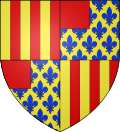
Count of Blois
The County of Blois was originally centred on Blois, south of Paris, France. One of the chief cities, along with Blois itself, was Chartres. Blois was associated with Champagne, Châtillon , and later with the French royal family, to whom the county passed in 1391...
, but was captured by him and imprisoned at Châteaudun, dying there under torture on 24 August 1153. His two sons, Hervé and Hugues, captured at the same time as their father, were only freed thanks to the intervention of their cousin Henry Plantagenet
Henry II of England
Henry II ruled as King of England , Count of Anjou, Count of Maine, Duke of Normandy, Duke of Aquitaine, Duke of Gascony, Count of Nantes, Lord of Ireland and, at various times, controlled parts of Wales, Scotland and western France. Henry, the great-grandson of William the Conqueror, was the...
, future king of England. Previously, the count of Blois had taken the precaution of razing the Amboise family fortress at Chaumont-sur-Loire
Chaumont-sur-Loire
Chaumont-sur-Loire is a commune in the Loir-et-Cher département in central France.-See also:* Château de Chaumont* Communes of the Loir-et-Cher department...
in Blois's territory. His grandson, also called Sulpice, married Elisabeth de Blois, countess of Chartres, and was the first banneret knight of Touraine (an order created by Philip-Augustus in 1213 to reward his knights' bravery against the English). From this date, Sulpice had the Amboise arms as Six pals d'or et de gueules.

Père Anselme
Père Anselme was a French genealogist.He was born in Paris in 1625. As a layman his name was Pierre Guibours...
, the Amboise family descended in this era via John I of Amboise, lord of Berry, son of Sulpice's brother Hugh of Amboise. This John found himself at Philip-Augustus's side at the French victory at battle of Bouvines
Battle of Bouvines
The Battle of Bouvines, 27 July 1214, was a conclusive medieval battle ending the twelve year old Angevin-Flanders War that was important to the early development of both the French state by confirming the French crown's sovereignty over the Angevin lands of Brittany and Normandy.Philip Augustus of...
. His son John II had two sons, Pierre II and Hugh, guaranteeing the Amboise line via two distinct lines. Pierre (originator of the older branch, which died out with Louis d'Amboise's death in 1469) married Jeanne de Rohan. Hugh was the origin of the Chaumont-d'Amboise branch, which survives to the present. Hugh's son John III of Amboise married Jeanne de Beaumont (direct descendant of Louis the Pious
Louis the Pious
Louis the Pious , also called the Fair, and the Debonaire, was the King of Aquitaine from 781. He was also King of the Franks and co-Emperor with his father, Charlemagne, from 813...
). He made his début in the Hundred Years' War
Hundred Years' War
The Hundred Years' War was a series of separate wars waged from 1337 to 1453 by the House of Valois and the House of Plantagenet, also known as the House of Anjou, for the French throne, which had become vacant upon the extinction of the senior Capetian line of French kings...
with Philip VI of France
Philip VI of France
Philip VI , known as the Fortunate and of Valois, was the King of France from 1328 to his death. He was also Count of Anjou, Maine, and Valois from 1325 to 1328...
and died at the Battle of Crecy
Battle of Crécy
The Battle of Crécy took place on 26 August 1346 near Crécy in northern France, and was one of the most important battles of the Hundred Years' War...
on 26 August 1346.
John III's son Hugh fought alongside his cousin Bertrand Duguesclin at the sieges of Ardres and Balinghem and died at the Battle of Agincourt
Battle of Agincourt
The Battle of Agincourt was a major English victory against a numerically superior French army in the Hundred Years' War. The battle occurred on Friday, 25 October 1415 , near modern-day Azincourt, in northern France...
on 25 October 1415, as did his eldest son. Having lost his father and grandfather at Agincourt, Pierre d'Amboise
Pierre d'Amboise
Pierre d'Amboise was a French nobleman of the House of Amboise. He was a son of Hugh VIII of Amboise, who was killed at the battle of Agincourt, and of Jeanne de Guénand...
inherited several fiefdoms in Blésois, Berry and Touraine, such as Chaumont-sur-Loire, Meillant, Preuilly, Bussy, Sagone, etc. He married Anne de Beuil, daughter of the count of Sancerre, and they had 17 children. His sons occupied high office at the start of the 16th century, the best known being Georges d'Amboise
Georges d'Amboise
Georges d'Amboise was a French Roman Catholic cardinal and minister of state. He belonged to the house of Amboise, a noble family possessed of considerable influence: of his nine brothers, four were bishops. His father, Pierre d'Amboise, seigneur de Chaumont, was chamberlain to Charles VII and...
(1460–1510), cardinal and first minister of Louis XII
Louis XII of France
Louis proved to be a popular king. At the end of his reign the crown deficit was no greater than it had been when he succeeded Charles VIII in 1498, despite several expensive military campaigns in Italy. His fiscal reforms of 1504 and 1508 tightened and improved procedures for the collection of taxes...
. Under Georges' rule taxes were not increased and he succeeded in reestablishing equitable justice for all, whilst he was also one of the main figures behind introducing the Renaissance
Renaissance
The Renaissance was a cultural movement that spanned roughly the 14th to the 17th century, beginning in Italy in the Late Middle Ages and later spreading to the rest of Europe. The term is also used more loosely to refer to the historical era, but since the changes of the Renaissance were not...
into France. Pierre's eldest son, Charles I of Amboise, was a favourite of Louis XI
Louis XI of France
Louis XI , called the Prudent , was the King of France from 1461 to 1483. He was the son of Charles VII of France and Mary of Anjou, a member of the House of Valois....
and worked heavily to give France the borders it has today. Count of Brienne, knight of the Ordre de Saint-Michel, governor of Île-de-France, Champagne and Burgundy, he fought in several wars in northern and eastern France. He had one son, Charles II d'Amboise de Chaumont, who accompanied king Charles VIII
Charles VIII of France
Charles VIII, called the Affable, , was King of France from 1483 to his death in 1498. Charles was a member of the House of Valois...
in his first Italian war
Italian Wars
The Italian Wars, often referred to as the Great Italian Wars or the Great Wars of Italy and sometimes as the Habsburg–Valois Wars, were a series of conflicts from 1494 to 1559 that involved, at various times, most of the city-states of Italy, the Papal States, most of the major states of Western...
, in October 1494.
16th century
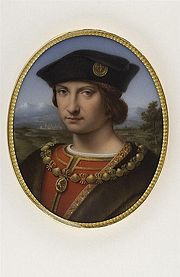

Georges d'Amboise
Georges d'Amboise was a French Roman Catholic cardinal and minister of state. He belonged to the house of Amboise, a noble family possessed of considerable influence: of his nine brothers, four were bishops. His father, Pierre d'Amboise, seigneur de Chaumont, was chamberlain to Charles VII and...
(a cardinal who tried and failed to become pope in 1503), John I of Amboise (bishops and duke of Langres), Louis I of Amboise (bishop of Albi), Pierre d'Amboise (bishop of Poitiers), Jacques d'Amboise
Jacques d'Amboise (bishop)
Jacques d'Amboise was a French religious dignitary and patron of medieval France. He was abbot of Jumièges then of Cluny, and bishop of Clermont. He was a member of the House of Amboise, an old noble family.-Life:...
(bishop of Clermont-Ferrand) and Hémery d'Amboise (grandmaster of the order of Saint John of Jerusalem based on Rhodes). The three other sons headed for a military career - Charles was governor of Île-de-France, Champagne and Burgundy, John was lord of Bussy and governor of Normandy, and Hugh was baron of Aubijoux and captain of the légionnaires of the Languedoc. Of his eight daughters, five married gentlemen from the highest families of the kingdom (Hanguest, Rochechouart, Gouffier, Tristan de Castelnau, Crespin) and two became abbesses (of Fontrevault and Saint-Ménéhould, with Madeleine d'Amboise at the latter).
At the start of the century five members of the family died in the Italian Wars, notably at the battles of and - these were:
- Hugh of Amboise, baron of Aubijoux, distinguished himself at the battle of Fornoue and was made king's lieutenant-general in Tuscany by Charles VIIICharles VIII of FranceCharles VIII, called the Affable, , was King of France from 1483 to his death in 1498. Charles was a member of the House of Valois...
. - Georges III of Amboise, Baron of Charenton, lord of Chaumont and Meillant, son of Charles II d'Amboise, gouvernor of Milan.(On his death all the Amboise family lands passed to his aunt Catherine d'AmboiseCatherine d'AmboiseCatherine d'Amboise was a prose writer and poet of the French Renaissance.-Family and life:Catherine was the daughter of Charles I d'Amboise and Catherine de Chauvigny. She would act as a patron for her nephew, the poet Michel d'Amboise....
, and then to the house of La Rochefoucault via Antoinette d'Amboise, niece of Catherine.) - Jacques d'Amboise, seigneur de Bussy.(son of John, governor of Normandy).
- Guy d'Amboise, seigneur de Ravel, son of Charles I of Amboise
- Charles II d'Amboise de Chaumont, viceroy of Lombardy, seigneur de Chaumont - led the French artillery at the capture of Alexandria and Tirano and acted as one of the main French generals in the Italian Wars, and was rewarded for his services by Louis XII by being made Grand Master of FranceGrand Master of FranceThe Grand Master of France was, during the Ancien Régime and Bourbon Restoration in France, one of the Great Officers of the Crown of France and head of the "Maison du Roi", the king's royal household...
(1502), marshal of FranceMarshal of FranceThe Marshal of France is a military distinction in contemporary France, not a military rank. It is granted to generals for exceptional achievements...
(1504, replacing the maréchal de Gié), then admiral of FranceAdmiral of FranceThe title Admiral of France is one of the Great Officers of the Crown of France, the naval equivalent of Marshal of France.The title was created in 1270 by Louis IX of France, during the Eighth Crusade. At the time it was equivalent to the office of Constable of France. The Admiral was responsible...
(1508, replacing his father-in-law Louis Malet de Graville). In 1503, Charles II d'Amboise had an illegitimate son, Michel d'Amboise, in Naples, whose descendants still exist.
1600 to 1792
.jpg)
.jpg)
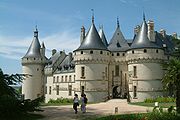
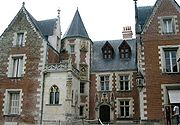
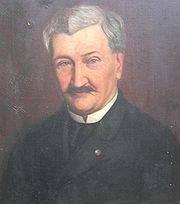

François d'Amboise
François d'Amboise was a French jurist and writer. He was counseller to the Parlement of Brittany and advocate general to the Grand Conseil.- Biography :...
, baron of La Chartre-sur-le-Loir
La Chartre-sur-le-Loir
La Chartre-sur-le-Loir is a commune in the Sarthe department in the Pays de la Loire region in north-western France.The surviving church dedicated to St. Vincent was designed by the architect Delarue circa 1830...
, was privy councillor and maître des requêtes to Henri IV
Henry IV of France
Henry IV , Henri-Quatre, was King of France from 1589 to 1610 and King of Navarre from 1572 to 1610. He was the first monarch of the Bourbon branch of the Capetian dynasty in France....
. The middle son, Adrien d'Amboise, was almoner to the king and bishop of Tréguier, and the youngest Jacques d'Amboise, rector of the university of Paris. Their cousin, Louis de Bussy d'Amboise, nicknamed "le brave Bussy", was at that time a favourite of the king's brother the duke of Alençon and a lover of the king's sister Marguerite, as well as being an excellent duellist (later becoming the protagonist of Alexandre Dumas's novel La Dame de Monsoreau
La Dame de Monsoreau
La Dame de Monsoreau is a novel by Alexandre Dumas, père. The novel is concerned with fraternal royal strife at the court of Henri III. Tragically caught between the millstones of history are the gallant Count de Bussy and the woman he adores, la Dame de Monsoreau....
). Louis's father, Jacques de Clermont-d'Amboise
Jacques de Clermont-d'Amboise
Jacques de Clermont-d'Amboise was the third son of Louis de Clermont, Lord of Gallerande, butler of the king, and Renée d'Amboise.-Titles:...
, had inherited the seigneuries of Bussy and Saxefontaine from cardinal Georges II d'Amboise, cardinal of Rouen.
Antoine d'Amboise, son of François, continued the line as lord of Neuilly and of Clos Lucé
Clos Lucé
Clos Lucé is a mansion in Amboise, France, located 500 metres from the royal Château d'Amboise, to which it is connected by an underground passageway. Built by Étienne le Loup in the middle of the fifteenth century, it was acquired in 1490 by Charles VIII of France for his wife, Anne de Bretagne...
at Amboise. By a brevet of 30 August 1643, Louis XIII
Louis XIII of France
Louis XIII was a Bourbon monarch who ruled as King of France and of Navarre from 1610 to 1643.Louis was only eight years old when he succeeded his father. His mother, Marie de Medici, acted as regent during Louis' minority...
made him maréchal de camp and governor of the citadel of Trin
Trin
Trin is a municipality in the district of Imboden in the Swiss canton of Graubünden. Crestasee is located in Trin.-Geography:Trin is perched on the mountain-side above the Rhine valley on the road between Domat/Ems and Flims. The village of Mulin is at the foot of the slope on the edge of the...
in Piedmont
Piedmont
Piedmont is one of the 20 regions of Italy. It has an area of 25,402 square kilometres and a population of about 4.4 million. The capital of Piedmont is Turin. The main local language is Piedmontese. Occitan is also spoken by a minority in the Occitan Valleys situated in the Provinces of...
. He fought in several battles in Italy and, in 1650, he gave his name to his regiment, from then on known as the régiment d'Amboise. Married to Anne de la Illière, they had only one child, Charles-Jules d'Amboise, godson of Mazarin and of the duchesse de Savoie.
Charles-Jules d'Amboise, married Charlotte de Gast. He was colonel of the régiment d'Amboise then colonel of the régiment de Touraine. In 1668, after the death without issue of his cousin François-Jacques d'Amboise, comte d'aubijoux and grandson of Louis d'Amboise d'Aubijoux, he recovered the full arms of the Amboise family: "six pals d'or et de gueules". Charles-Jules died on 28 February 1627 and was buried with his ancestors in the church of the cordeliers
Cordeliers
The Cordeliers, also known as the Club of the Cordeliers, Cordeliers Club, or Club des Cordeliers and formally as the Society of the Friends of the Rights of Man and of the Citizen , was a populist club during the French Revolution.-History:The club had its origins in the Cordeliers district, a...
d'Amboise, though this was later destroyed in the Revolution.
Charles-Jules's grandson Henri-Michel d'Amboise was colonel of the compagnie des grenadiers of Touraine and knight of the Ordre royal et militaire de Saint-Louis. During the 1789 French Revolution
French Revolution
The French Revolution , sometimes distinguished as the 'Great French Revolution' , was a period of radical social and political upheaval in France and Europe. The absolute monarchy that had ruled France for centuries collapsed in three years...
he was elected deputy for the nobility for Touraine and in 1793 was imprisoned in Abbaye de Port-Royal de Paris, only being released in 1794 after Maximilien de Robespierre's death. He saved his château du Clos Lucé at Amboise (former residence of Léonard de Vinci). Henri-Michel was buried on 25 October 1812 in the cemetery of Amboise beside the duke of Choiseul - his tomb is now a monument historique
Monument historique
A monument historique is a National Heritage Site of France. It also refers to a state procedure in France by which national heritage protection is extended to a building or a specific part of a building, a collection of buildings, or gardens, bridges, and other structures, because of their...
.
1792 to present
After the death of Henri-Michel, his son, Georges-Alexis d'Amboise who lived at château de Pray, near AmboiseAmboise
Amboise is a commune in the Indre-et-Loire department in central France. It lies on the banks of the Loire River, east of Tours. Today a small market town, it was once home of the French royal court...
, left France for England. In London he married Louisa Barwell, daughter of Richard Barwell
Richard Barwell
Richard Barwell was an Anglo-Indian writer and politician.Barwell was the son of William Barwell, governor of Bengal in 1748, and afterwards a director of the East India Company, and Sheriff of Surrey in 1768...
, MP. Georges-Alexis accompanied king Louis XVIII
Louis XVIII of France
Louis XVIII , known as "the Unavoidable", was King of France and of Navarre from 1814 to 1824, omitting the Hundred Days in 1815...
, and the princes to Ghent
Ghent
Ghent is a city and a municipality located in the Flemish region of Belgium. It is the capital and biggest city of the East Flanders province. The city started as a settlement at the confluence of the Rivers Scheldt and Lys and in the Middle Ages became one of the largest and richest cities of...
during the Hundred Days
Hundred Days
The Hundred Days, sometimes known as the Hundred Days of Napoleon or Napoleon's Hundred Days for specificity, marked the period between Emperor Napoleon I of France's return from exile on Elba to Paris on 20 March 1815 and the second restoration of King Louis XVIII on 8 July 1815...
. After the battle of Waterloo
Battle of Waterloo
The Battle of Waterloo was fought on Sunday 18 June 1815 near Waterloo in present-day Belgium, then part of the United Kingdom of the Netherlands...
he returned to France as a captain in the compagnie du Luxembourg. On 8 July 1819, Louis XVIII
Louis XVIII of France
Louis XVIII , known as "the Unavoidable", was King of France and of Navarre from 1814 to 1824, omitting the Hundred Days in 1815...
personally decorated him with the royal légion d'honneur
Légion d'honneur
The Legion of Honour, or in full the National Order of the Legion of Honour is a French order established by Napoleon Bonaparte, First Consul of the Consulat which succeeded to the First Republic, on 19 May 1802...
.
Georges-Charles d'Amboise, (his son), and Charles-Eugène d'Amboise, (his grandson), only returned to France at the end of the 19th century. They both set up home in Provence, near Arles
Arles
Arles is a city and commune in the south of France, in the Bouches-du-Rhône department, of which it is a subprefecture, in the former province of Provence....
. For more than a century the descendents of Charles-Eugène d'Amboise remained in this region, and at the start of the 21st century there are still two direct male descendents of this noble family - Alain-Georges d'Amboise and his brother Thierry d'Amboise.

